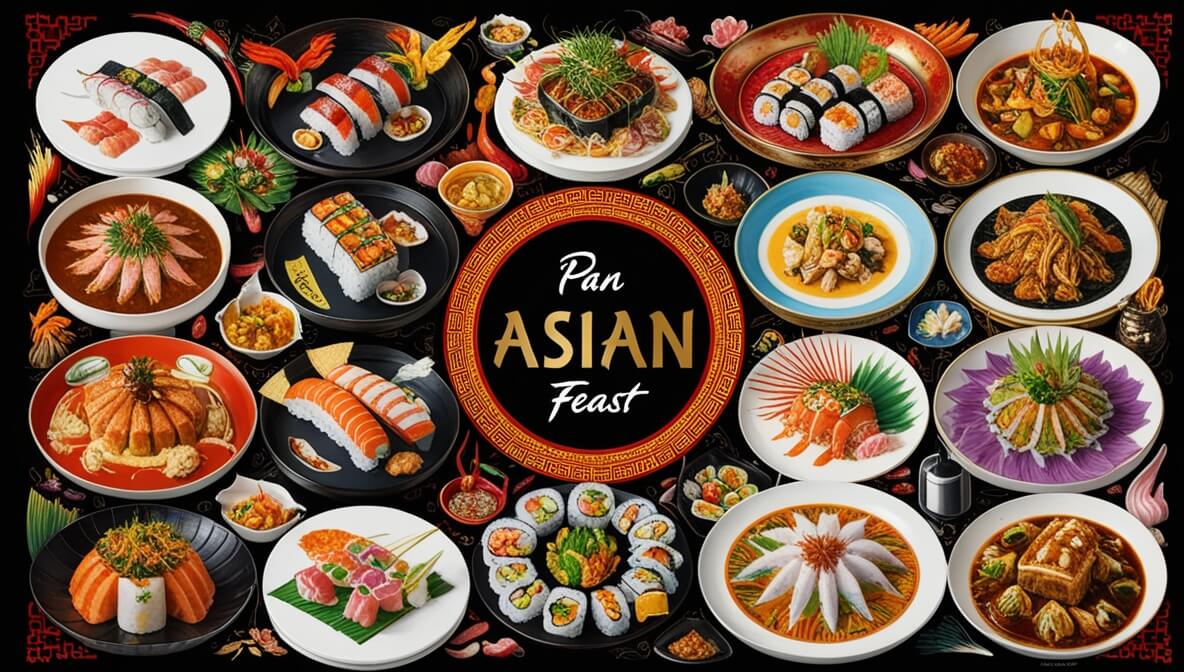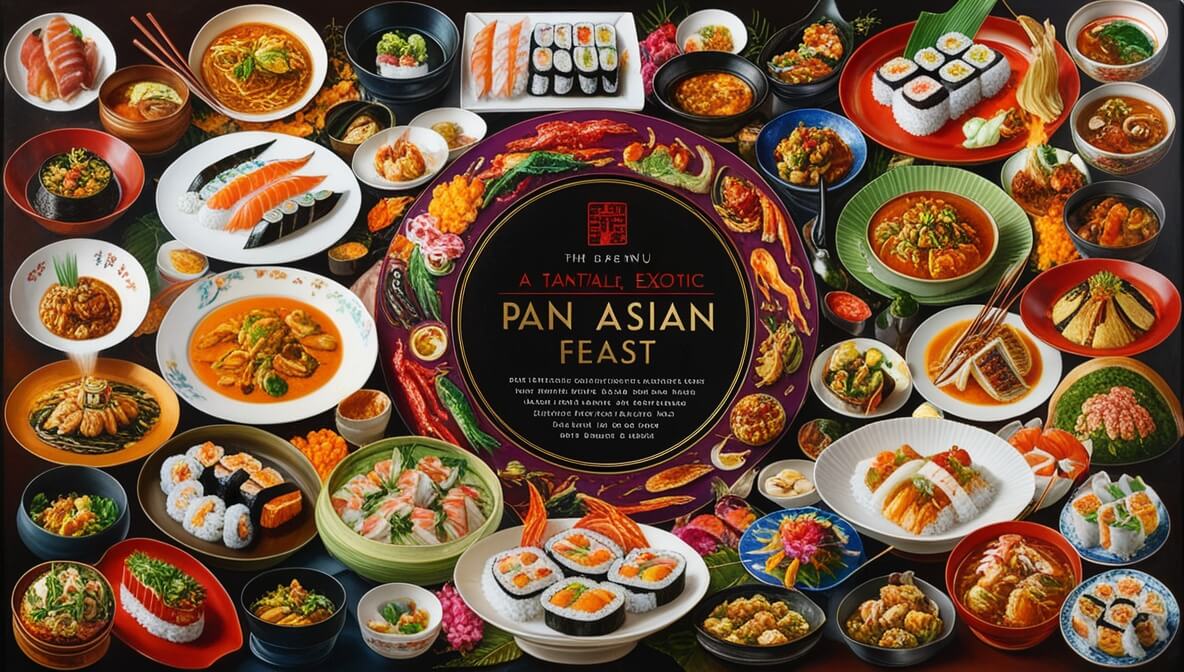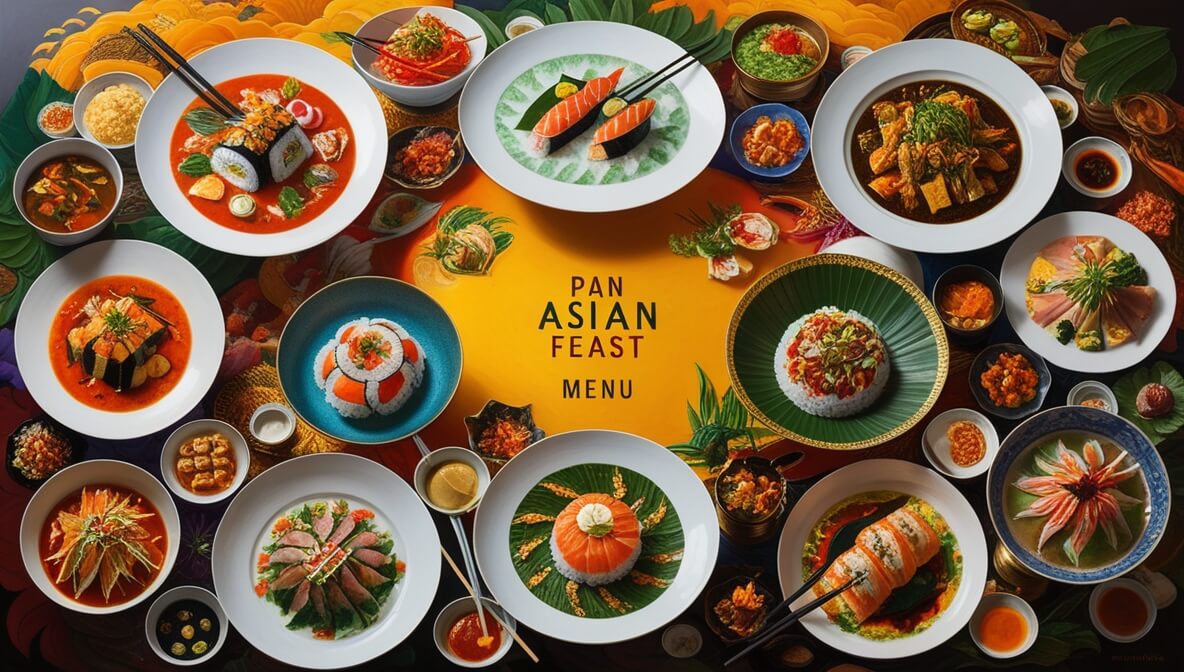Originally posted on September 29, 2024 @ 6:34 pm
Pan-Asian cuisine is a culinary style that celebrates the diverse flavors and traditions of various Asian countries.
It is a harmonious fusion of ingredients, cooking techniques, and cultural influences from regions such as China, Japan, Thailand, Vietnam, and Korea.
This melting pot of flavors creates a unique and exciting dining experience that tantalizes the taste buds with every bite.
At the heart of Pan-Asian cuisine lies a rich tapestry of flavors, ranging from the bold and spicy to the delicate and subtle.
The skillful blending of aromatic spices, fresh herbs, and umami-rich sauces results in dishes that are bursting with complexity and depth.
From the fiery curries of Thailand to the delicate sushi rolls of Japan, and the comforting noodle soups of China, Pan-Asian menus offer a diverse array of culinary delights.
The beauty of Pan-Asian cuisine lies in its ability to seamlessly blend traditional recipes with modern interpretations, creating a harmonious fusion that celebrates the best of each culture.
Chefs expertly combine time-honored techniques with innovative twists, resulting in dishes that are both familiar and excitingly new.
Whether it’s the delicate art of dim sum or the bold flavors of Korean barbecue, Pan-Asian cuisine invites diners on a flavorful journey across the vibrant landscapes of Asia.
What is Pan-Asian Cuisine?

Pan-Asian cuisine is a culinary term that encompasses the diverse flavors and cooking styles from various Asian countries. It represents a fusion of techniques, ingredients, and dishes from regions such as China, Japan, Korea, Thailand, Vietnam, and others. Pan-Asian restaurants aim to offer a sampling of these diverse culinary traditions under one roof, providing diners with a taste of the rich and varied flavors of Asia.
The origins of Pan-Asian cuisine can be traced back to the late 20th century when Asian communities began to establish themselves in major cities around the world. As these communities grew, so did the demand for authentic Asian flavors. Chefs and restaurateurs recognized the opportunity to combine the best elements of different Asian cuisines, creating a unique and exciting dining experience.
Key characteristics of Pan-Asian cuisine include the use of bold and aromatic spices, fresh herbs, and a harmonious balance of flavors. Common ingredients found in Pan-Asian dishes include soy sauce, rice vinegar, sesame oil, ginger, garlic, chili peppers, and a variety of vegetables and proteins like tofu, chicken, beef, and seafood.
One of the hallmarks of Pan-Asian cuisine is the emphasis on fresh, high-quality ingredients. Chefs often source locally grown produce and use traditional cooking techniques to preserve the natural flavors of the ingredients. Dishes are carefully crafted to showcase the interplay of textures, colors, and aromas, creating a truly sensory experience for diners.
Buddakan NYC Menu Highlights

Nestled in the heart of New York City, Buddakan offers a tantalizing journey through Pan-Asian flavors. Their menu is a harmonious fusion of diverse culinary traditions, showcasing the best of Chinese, Japanese, and Thai cuisines.
Dim sum is a highlight at Buddakan, with an array of delectable dumplings and steamed bites that tantalize the taste buds. From classic pork and shrimp shumai to innovative creations like the truffle edamame dumplings, each bite is a delightful exploration of textures and flavors.
For those seeking comfort in a bowl, Buddakan’s noodle soups are a must-try. The rich and aromatic broths are carefully crafted, infusing each slurp with an explosion of authentic flavors. The seafood noodle soup, brimming with fresh catches and perfectly cooked noodles, is a particular standout.
Seafood enthusiasts will delight in Buddakan’s extensive selection of ocean-fresh delicacies. From the succulent Chilean sea bass to the expertly prepared sushi and sashimi platters, each dish is a celebration of the bounties of the sea.
No visit to Buddakan would be complete without indulging in their legendary Peking duck. Expertly roasted to achieve a crispy, golden-brown skin and tender, juicy meat, this dish is a true culinary masterpiece. Served with traditional accompaniments, it’s a feast for the senses.
For those seeking a hands-on culinary experience, Buddakan offers Dumpling Making Classes. Guided by experienced chefs, participants can learn the art of crafting delicate dumplings, from mixing the dough to expertly folding and pleating the parcels of flavor. It’s a unique opportunity to immerse oneself in the rich traditions of Pan-Asian cuisine.
Other Popular Pan-Asian Restaurants

Pan Asia (Nashua, NH) offers a diverse menu that showcases the best of Pan-Asian cuisine. From sizzling stir-fries to fragrant curries, their dishes are bursting with authentic flavors. Their extensive menu features a wide range of options, catering to various dietary preferences and taste buds.
New Pan Asian (North Howell, NJ) prides itself on using only the freshest and most natural ingredients in their dishes. Their commitment to quality shines through in every bite, whether you’re savoring their delicate dim sum or indulging in their signature noodle dishes. The restaurant’s warm and inviting atmosphere perfectly complements the vibrant flavors on the menu.
New York City is a mecca for Pan-Asian cuisine, with numerous restaurants offering a fusion of flavors from across the continent. TAO Uptown and Sei Less are two notable establishments that have garnered a loyal following among locals and visitors alike. These restaurants showcase the diversity of Pan-Asian cuisine, with menus featuring everything from dim sum and noodle soups to expertly prepared seafood dishes.
Nestled within the Silver Reef Casino Resort in Washington, Panasia offers a unique dining experience that combines the excitement of a casino with the flavors of Pan-Asian cuisine. Their menu features a tantalizing array of appetizers and entrées, allowing diners to embark on a culinary adventure without leaving the resort.
Pan Asia Restaurant (Boston) is a beloved institution in the city, renowned for its authentic and flavorful dishes. From Thai appetizers that tantalize the taste buds to hearty entrées that satisfy even the heartiest of appetites, this restaurant offers a true taste of Pan-Asian cuisine.
In the charming town of Brattleboro, Vermont, Panasian has become a local favorite for its diverse menu and welcoming atmosphere. Whether you’re in the mood for a steaming bowl of noodle soup or a sizzling stir-fry, this restaurant has something to please every palate. Their menu is neatly organized into categories such as appetizers, soups, poultry, pork, beef, seafood, vegetables, fried rice, and lo mein, making it easy to navigate and find your desired dish.
Pan Asia (Barnegat, NJ) specializes in the flavors of Chinese and Japanese cuisine, offering a unique fusion of these two culinary traditions. From delicate sushi rolls to hearty noodle dishes, this restaurant provides a taste of the diverse and rich flavors that define Pan-Asian cuisine.
Common Pan-Asian Menu Items
Across Pan-Asian restaurants, menus often feature a diverse array of appetizers, noodle dishes, main courses, and special dishes that showcase the fusion of flavors from various Asian cuisines.
Appetizers
Appetizers are a delightful way to begin your Pan-Asian dining experience. Edamame, boiled and salted soybeans, are a popular choice, providing a tasty and healthy starter. Fried tofu, crispy on the outside and soft on the inside, is another common offering, often served with a dipping sauce. Dumplings, whether steamed or pan-fried, are a beloved favorite, filled with savory ingredients like pork, shrimp, or vegetables. Egg rolls, with their crispy exterior and flavorful fillings, are a classic appetizer that never disappoints.
Noodle Dishes
Noodle dishes are a staple in Pan-Asian cuisine, offering a comforting and satisfying experience. Pad Thai, a beloved Thai dish, features stir-fried rice noodles with a tangy and slightly sweet sauce, mixed with bean sprouts, eggs, and your choice of protein. Lo Mein, a Chinese noodle dish, combines soft, chewy egg noodles with a variety of vegetables and proteins, all tossed in a savory sauce. Fried rice, a versatile dish found across many Asian cuisines, combines fluffy rice with vegetables, eggs, and your choice of meat or seafood, infused with aromatic flavors.
Main Courses
The main course selections in Pan-Asian restaurants are truly diverse, catering to various tastes and dietary preferences. Poultry dishes, such as chicken or duck, are often prepared with fragrant spices and flavorful sauces. Pork dishes, like sweet and sour pork or twice-cooked pork belly, offer a delightful balance of flavors. Beef dishes, like Mongolian beef or beef and broccoli, are hearty and satisfying. Seafood enthusiasts can indulge in a variety of options, from crispy shrimp tempura to grilled salmon with teriyaki glaze. Vegetable dishes, like stir-fried mixed vegetables or vegetable curries, provide flavorful and nutritious options for plant-based diners.
Special Dishes
Many Pan-Asian restaurants feature special dishes that showcase the chef’s creativity and expertise. Chef-recommended dishes often highlight unique flavor combinations or traditional recipes passed down through generations. Soups, like hot and sour soup or miso soup, are comforting and flavorful options that can be enjoyed as an appetizer or a light meal. Peking duck, a beloved Chinese dish, is a labor-intensive preparation that results in a crispy skin and tender, juicy meat, often served with thin pancakes and condiments.
Exploring Pan-Asian Flavors
Pan-Asian cuisine is a delightful fusion of flavors from various Asian countries, creating a unique and diverse culinary experience. One of the hallmarks of this cuisine is the seamless blending of ingredients and cooking techniques from different regions, resulting in dishes that are both familiar and excitingly new.
At the heart of Pan-Asian flavors lies a harmonious balance of sweet, sour, salty, and spicy tastes. Chefs skillfully combine ingredients like soy sauce, rice vinegar, sesame oil, ginger, garlic, and a variety of chilies to achieve this delicate balance. The use of aromatic spices such as star anise, cinnamon, and cloves adds depth and complexity to the dishes.
Unique ingredients like fish sauce, shrimp paste, and fermented soybean paste (miso) lend distinct umami flavors to Pan-Asian dishes. These ingredients, often used in small quantities, pack a powerful punch and contribute to the savory richness that defines many Pan-Asian meals.
Cooking techniques also play a crucial role in shaping the flavors of Pan-Asian cuisine. Stir-frying, a method that originated in China, is a popular way to quickly cook vegetables, meats, and seafood while preserving their natural flavors and textures. Steaming, another traditional Chinese technique, gently cooks delicate ingredients like dumplings and buns, allowing their subtle flavors to shine through.
Pan-Asian chefs also incorporate techniques from other Asian cuisines, such as the use of curries and coconut milk from Thai cuisine, or the art of grilling and smoking from Japanese cuisine. This fusion of techniques adds layers of complexity and depth to the dishes, creating a truly unique and memorable dining experience.
Whether it’s the bold and spicy flavors of Thai curries, the delicate and umami-rich tastes of Japanese sushi, or the rich and aromatic dishes of Chinese cuisine, Pan-Asian flavors offer a captivating journey for the senses. Each bite is a celebration of the diversity and richness of Asian culinary traditions, expertly blended to create something truly special.
Dietary Considerations at Pan-Asian Restaurants
Pan-Asian restaurants often cater to a wide range of dietary preferences and restrictions, making them an excellent choice for diners with specific dietary needs. Whether you’re a vegetarian, vegan, or following a gluten-free diet, you’ll find plenty of options on most Pan-Asian menus.
For vegetarians, many Pan-Asian restaurants offer a variety of meat-free dishes, such as stir-fried vegetables, tofu dishes, and vegetable-based noodle dishes. Vegans can also find suitable options, as many dishes can be prepared without animal products like eggs or dairy. Be sure to inform your server about your dietary requirements, and they can guide you through the menu or suggest modifications to existing dishes.
Gluten-free diners can enjoy a wide range of Pan-Asian cuisine, as many dishes are naturally gluten-free or can be easily modified. Rice-based dishes, such as fried rice or rice noodles, are often safe options. Additionally, many restaurants offer gluten-free soy sauce or tamari, allowing you to enjoy your favorite dishes without worry.
Beyond these common dietary restrictions, Pan-Asian restaurants may also accommodate other dietary needs, such as nut allergies or preferences for halal or kosher options. Don’t hesitate to discuss your requirements with the restaurant staff, as they are often willing to make adjustments to ensure a satisfying dining experience for all guests.
Choosing the Right Pan-Asian Restaurant
When it comes to selecting the perfect Pan-Asian restaurant, there are several factors to consider. First and foremost, it’s essential to determine your culinary preferences and dietary restrictions. Pan-Asian cuisine encompasses a wide range of flavors and ingredients, so it’s crucial to ensure that the restaurant you choose can accommodate your specific needs.
One of the best ways to narrow down your options is by thoroughly reviewing the restaurant’s menu online. Most reputable establishments have their menus readily available on their websites, allowing you to browse through the various dishes and get a sense of the culinary offerings. Pay close attention to the menu descriptions, as they can provide valuable insights into the ingredients used and the preparation methods employed.
For those with dietary restrictions or preferences, such as vegetarian, vegan, or gluten-free diets, it’s advisable to look for restaurants that clearly indicate suitable options on their menus. Many Pan-Asian restaurants have adapted their offerings to cater to diverse dietary needs, ensuring that everyone can enjoy a delightful dining experience.
When selecting a Pan-Asian restaurant, it’s also essential to consider factors such as ambiance, service, and overall reputation. Reading online reviews and seeking recommendations from friends or food enthusiasts can help you make an informed decision. Additionally, some restaurants may offer special events or cooking classes, which can be an added bonus for those seeking a more immersive culinary experience.
Remember, the key to choosing the right Pan-Asian restaurant is to take the time to research and understand your options thoroughly. By considering your preferences, dietary needs, and the restaurant’s offerings, you can ensure a memorable and satisfying dining experience that celebrates the rich diversity of Pan-Asian cuisine.
The Pan-Asian Dining Experience
Stepping into a Pan-Asian restaurant is an invitation to embark on a multi-sensory journey. The ambiance is carefully curated to transport diners to the vibrant streets of Asia, with intricate decor, traditional artwork, and ambient lighting setting the stage for an immersive experience.
Upon being seated, attentive servers greet you with warm smiles and a wealth of knowledge about the menu. They are eager to guide you through the diverse array of flavors, offering recommendations and explaining the unique ingredients and preparation techniques used in each dish.
As you peruse the menu, the tantalizing aromas of sizzling woks, fragrant spices, and simmering broths fill the air, whetting your appetite. The presentation of each dish is a feast for the eyes, with vibrant colors, artful plating, and garnishes that showcase the chef’s attention to detail.
The dining experience at a Pan-Asian restaurant is designed to be shared and savored. Dishes are often served family-style, encouraging diners to sample a variety of flavors and textures. From the delicate folds of dumplings to the bold and complex curries, each bite is a celebration of culinary traditions that have been perfected over centuries.
Beyond the food itself, the service at Pan-Asian restaurants is renowned for its warmth and hospitality. Servers are attentive yet unobtrusive, ensuring that your dining experience is seamless and enjoyable from start to finish.
As the meal draws to a close, you may find yourself lingering over a pot of fragrant tea or a dessert that perfectly balances sweet and savory notes. The Pan-Asian dining experience is not just about satiating hunger; it’s about savoring every moment, every flavor, and every aspect of a rich cultural tapestry woven into each dish.
Conclusion
The world of Pan-Asian cuisine is a delightful fusion of flavors, ingredients, and cooking techniques from various Asian countries. From the steaming bowls of noodle soups to the delicate artistry of dim sum, and the bold flavors of Thai curries to the delicate sweetness of Japanese sushi, Pan-Asian menus offer a diverse and exciting culinary adventure.
If you haven’t yet explored the rich tapestry of Pan-Asian dining, now is the perfect time to embark on this flavorful journey. Visit the websites of the featured restaurants or search for Pan-Asian eateries in your area to peruse their tantalizing menus. Don’t hesitate to step out of your comfort zone and try something new – you may just discover your new favorite dish!
To fully immerse yourself in the Pan-Asian experience, make a reservation at a renowned establishment or place an order for takeout or delivery. Savor the authentic flavors, embrace the fusion of cultures, and let your taste buds embark on a culinary odyssey through Asia’s diverse cuisines.
Remember, the beauty of Pan-Asian cuisine lies in its ability to surprise and delight with each bite. So, open your mind and your palate to the endless possibilities, and let the flavors of Asia transport you to a world of gastronomic bliss.


